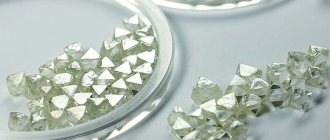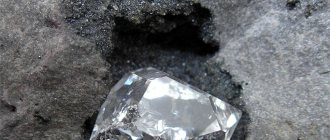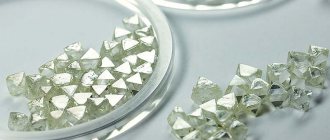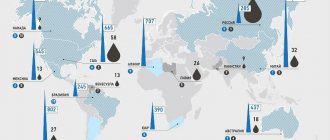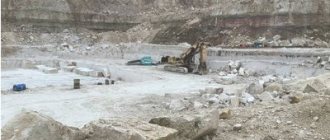Everyone knows that diamond is the most precious stone on earth. It is unique in that it is the hardest, most radiant and sparkling among minerals; its external characteristics are not subject to time, mechanical damage and even fire. Both thousands of years ago and now, diamonds attract humanity, beckoning with their cold beauty. Processed diamonds not only produce magnificent diamonds that adorn luxury jewelry, they are also (due to their properties) used in many industrial sectors. There are enough deposits where diamonds can be found in Russia to say that our country is a diamond power. In this article we will tell you more about the extraction of such a useful and beautiful mineral. So, further about where diamonds are mined in Russia: cities, location of deposits.
Diamonds in nature
In the upper mantle of the Earth, at a depth of more than 100-150 km, under the influence of high temperatures and enormous pressure, pure carbon atoms from the graphite state are modified into crystals, which we call diamonds. This crystallization process takes hundreds of years. After spending several million years in its depths, diamonds are brought to the surface of the earth by kimberlite magma during volcanic explosions. With such an explosion, so-called pipes are formed - kimberlite diamond deposits. The name “kimberlite” comes from the African town of Kimberley, in the area of which diamond-bearing rock was discovered. Nowadays, there are two types of diamond deposits: primary (lamproite and kimberlite) and secondary (placers).
Diamonds were known to mankind three thousand years before our era; the first mentions of them were found in India. People immediately endowed diamond with supernatural properties, thanks to its indestructible hardness, brilliance and transparent purity. It was accessible only to selected persons who had power and authority.
How is a diamond different from a diamond?
Many people confuse these two words, but they are what distinguish the mined mineral from the finished piece of jewelry. The moment a mineral is in the ground, in the back of a mining truck, or in a warehouse awaiting cutting, it is a diamond. Once it is processed, it becomes a diamond.
Few people know, but diamonds can be broken if you hit them very hard. They split into pieces along planes parallel to the faces of a regular octahedron. This is exactly the structure it has. Roughly speaking, it is splitting “at the seams.”
The word diamond translated from French “brilliant” means “brilliant”. This is exactly what it becomes after processing, and the processing itself involves applying 57 or 58 facets to the surface of the stone. They refract light and give the stone that very radiance for which it is so valued.
On the left is a diamond, on the right is a diamond. There is a difference, right?
About 75 percent of diamonds sold in the world are classically cut. This form consists of the following elements:
- Crown (top)
- Girdle (widest part)
- Pavilion (lower part)
Despite the fact that the diamond itself will be beautiful even with cutting defects, and only a specialist can recognize the defect, a special technique is used here. Craftsmen have been studying how to cut diamonds correctly for many years, and they must observe the cut proportions as correctly as possible.
If the cut is made other than the classic or fancy shape, it is divided into two types. Without going into detail, this is a shape closer to round or, conversely, closer to an elongated shape.
Diamond producing countries
Since each diamond is unique in its kind, it is customary to separate their accounting among world countries according to production volumes and in value terms. The bulk of diamond production is distributed among only nine countries. These are Russia, the Republic of Congo, Botswana, Australia, Canada, Angola, South Africa, Zimbabwe and Namibia.
In value terms, the leaders among these countries are Russia, African Botswana and Canada. Their total diamond production accounts for more than 60% of the value of the world's mined diamonds.
For less than 2022 (according to the latest data), Russia takes first place in terms of production volumes and value. Its share in value terms accounts for about 40% of total world production. This leadership has belonged to Russia for several years.
Synthetic minerals
People have long dreamed of learning how to create this non-metal on their own, but this only happened in the 20th century. Carbon, or more precisely its source - graphite, is subjected to extreme pressure and high temperature. This occurs using a hydraulic press and electric current. Forming diamonds this way is reliable, but expensive.
There are two more methods by which artificial “kings of stones” appear: by exposure to an explosion and by growing crystals in a methane environment. Artificial minerals are more often used in production than in jewelry, although they are in no way inferior to natural ones.
The basis of production, carbon, is a very common material, so there are no problems with the extraction of raw materials for the artificial creation of stones. In terms of price, quality and availability, the best raw material is graphite, which is why it is used most often.
By the way, the synthetic production of such stones contributed to the discovery of a new, even more durable material. It was called ACNR. This stone, which can also be formed from carbon through heat, can even scratch a diamond. Perhaps future generations will widely use it in practice.
The first diamond in the Russian Federation
Now in more detail about production in our country. When and where did diamond mining in Russia first begin? This happened in the 19th century, in the summer of 1829, the serf teenager Pavel Popov, panning for gold at the Krestovozdvizhensky gold mine in the Perm province, found an incomprehensible pebble. The boy gave it to the caretaker and after assessing the precious find, he was given his freedom, and all other workers were told to pay attention to all the transparent stones. So two more diamonds were found. Humboldt, a former German geologist nearby, was told about the place where diamonds are mined in Russia. Then the development of the diamond mine began.
Over the next thirty years, about 130 diamonds were discovered, weighing a total of 60 carats. In total, before 1917, no more than 250 precious stones were found in Russia, where diamonds were mined in the Urals. But, despite the insignificant number, they were all of excellent beauty. These were stones worthy of decorating jewelry.
Already in 1937, large-scale expeditions were organized in Soviet Russia to explore Ural diamonds, but they were not crowned with great success. The placers found were poor in precious stone content; primary diamond deposits were never discovered in the Urals.
Technological cycle
The placers are found in sands that require a beneficiation process. In primary deposits, stones are interspersed with mountain kimberlite. The development of placer deposits presents certain difficulties:
- the need to restore large areas of soil removed during the mining process;
- removal from the raw material processing point;
- moving equipment to a new location when the previous one is depleted.
A quarry or mine has fewer disadvantages and allows for the extraction of large volumes of stones. The technological cycle for any mining method includes:
- geological exploration, calculations of approximate volumes of deposits;
- acquisition of special equipment;
- equipment of the excavation site;
- rock mining;
- delivery to the mining factory.
Often the cycle includes the construction of a processing plant - it is cheaper to cut and polish stones within one company than to transport them somewhere.
Siberian diamonds
Since the 18th century, the best minds of our country have wondered where the diamond deposits are in Russia. The great Russian scientist of the 18th century, Mikhail Lomonosov, stated in his writings that Siberia could be a diamond-bearing region. He outlined his assumption in the manuscript “Diamonds Could Have Occurred in the Northern Lands.” However, the first Siberian diamond was found at the end of the 19th century on the Melnichnaya River, near the city of Yeniseisk. Due to the fact that it weighed only two-thirds of a carat, and also due to a lack of funding, exploration of other diamonds in the area was not continued.
And only in 1949 in Yakutia on the Sokolinaya Spit, near the village of Krestya in the Suntarsky Ulus, the first Siberian diamond was found. But this deposit was alluvial. The search for indigenous kimberlite pipes was crowned with success five years later - the first pipe not located in Africa was found near the Daldyn River by geologist Popugaeva. This was a significant discovery in the life of our country. The name of the first diamond-bearing pipe was given in the Soviet style of that time - “Zarnitsa”. The next to be discovered were the Mir pipe and the Udachnaya pipe, where diamonds are still mined in Russia. By the end of 1955, 15 new diamond pipe deposits appeared in Yakutia.
Yakutia, or as the locals call this region, the Republic of Sakha, is the place where gold and diamonds are mined in Russia. Despite the severity of the climate, it is a fertile and generous region, giving our country natural resources.
Below is a map that clearly shows where these precious stones are mined in Russia. The darkest territories are the places where there are the largest number of deposits, and the diamonds themselves are the most expensive in value. As you can see, most of the pipes are concentrated in the Republic of Sakha (Yakutia). There are also diamonds in the Krasnoyarsk Territory, Irkutsk Region, the Republic of Karelia, the Arkhangelsk and Murmansk Regions, the Perm Territory, the Komi Republic and so on.
Prevalence and origin
A. is found in kimberlites, lamproites, and “related” igneous rocks. rocks (some types of lamprophyres, picrites, peridotites), as well as in decomposition. placers. A., sharply different from the above types (carbonado, carbonado with lonsdaleite), are sometimes found in impactites that fill astroblemes, in metamorphic. rocks, as well as in meteorites. There is no consensus on the origin of A. Origin of A. kimberlite-lamproitic type b. h. Scientists connect with the upper mantle of the Earth, with the depths of St. 150 km, where it crystallizes into deep igneous rocks. ultrabasic (peridotites) and basic (eclogites) rocks and is located there at extremely high pressures (40–65, up to 1.05 107 kPa) and temperatures of approx. 1150–1350 °C. Most researchers recognize that kimberlite or lamproite magma (filling diatremes), previously considered to be many others. researchers study the environment of A. formation, plays the role of a transporter in this process. Depending on its properties (temperature, the rate of rise of the magmatic column, the content of various chemical elements, especially alkaline ones), it can both preserve the material quite well and be extremely aggressive towards it - up to its complete dissolution and/or conversion to graphite. Genesis of A. in metamorphic. breeds b. Many researchers explain their formation at low temperatures and pressures in the upper horizons of the earth's crust simultaneously with the formation of host rocks. According to an alternative point of view, these A. are initially associated with the mantle diamond-bearing ultrabasic rock, which penetrated into the upper horizons of the crust, then transformed there (almost completely changing its chemical and mineral composition) as a result of the influence of metasomatics. processes. Formation of polycrystalline. A. (carbonado, carbonado with lonsdaleite), contained in astrobleme impactites, is explained by the recrystallization of graphite of ancient metamorphic rocks. graphite-containing rocks as a result of the so-called. shock metamorphism of impact (intrusion of a large meteorite) or explosive nature (endogenous explosive structure).
Mirny is the city with the most diamonds in Russia
In the summer of 1955, geologists searching for kimberlite pipes in Yakutia saw a larch tree with exposed roots. This fox dug a hole here. The color of the scattered earth was bluish, which is a characteristic feature of kimberlite. The geologists were not mistaken in their guesses, and after some time they sent a coded message to the top Soviet leadership: “We smoked the pipe of peace, the tobacco is excellent!” A year later, in the west of Yakutia, large-scale development of the Mir kimberlite pipe begins, similar to quarry excavations.
Around a huge quarry in the form of a funnel, a village is formed, named in his honor - Mirny. Within two years, the village turns into the city of Mirny, today it is a city with a population of more than three tens of thousands of residents, 80% of whom are employed in the diamond mining enterprise. It can rightfully be called the diamond capital of Russia, because millions of dollars worth of diamonds are mined here every year.
Now it is the largest quarry not only in Russia, where diamonds are mined, but throughout the world. The depth of the huge quarry is 525 meters, its diameter is about 1200 meters, the quarry could easily accommodate the Ostankino TV tower. And when descending to the center of the quarry, the length of the serpentine road is more than 8 kilometers.
Below in the photo is just this diamond quarry (Mirny, Yakutia).
Drilling and blasting works
Experts fill the wells with ammonium nitrate. Approximately 800 grams of detonator is inserted into each hole and the explosion site is marked. Everything is carried out according to plan. After all the equipment leaves the site, the detonator wire is set on fire.
The first excavator to appear in the danger zone after the explosion. The operator has a few minutes to fill the truck with cargo. One wrong move and the giant will fall down.
The CAT dump truck picks up four full buckets. Only such a machine can transport cargo.
The final step is processing. The plant operates around the clock. 12 thousand tons of ore are processed per day. The company performs the following operations:
- crushed;
- washed;
- cleanse;
- sort the ore.
After processing, the material is sent for sorting to Belgium.
This is one of the most remote mines on earth. The only road is the ice path. Equipment can only be delivered to the camp from February to April. The cargo that cannot be sent by plane is ammonium nitrate.
Cars drive a kilometer apart from each other. The equipment is serviced once a month. In extreme conditions, cars are repaired within 48 hours.
The area of the Diavik mine (Canada) is 10 square km. The mine processes 2 million tons of rock annually. How are diamonds extracted from the mine? The process consists of the following stages:
- Delivery of the breed.
- Primary crusher.
- Mixing ore with water and grinding to 30 mm.
- Diamond extraction cycle.
- Separation of crystals using X-rays.
In addition to stone mining, Canada continues to search for new deposits.
"Yakutalmaz"
The Yakutalmaz trust was created in 1957 in the tent village of Mirny at that time with the aim of developing mining operations for diamond extraction. Exploration of the following deposits was carried out in the difficult conditions of the deep taiga, with severe frosts of 60 degrees and the absence of any infrastructure. Thus, in 1961, almost near the Arctic Circle, the development of the Aikhal pipe began, and in 1969 another pipe was discovered - the International pipe - the most diamond-bearing pipe to date.
In the 1970s and 1980s, several more diamond mines were opened through underground nuclear explosions. The International, Yubileynaya, and other pipes were discovered in this way. In the same years, Yakutalmaz opened the world’s only kimberlite museum in the city of Mirny. At first, the exhibits represented private collections of geologists, but over time they became more numerous. Here you can see various rocks of kimberlite - a harbinger of diamonds, from different kimberlite pipes around the world.
Diamond industry in recent history
Since 1980, global industrial production of diamonds has increased 3-4 times, but, nevertheless, diamonds are still considered an extremely scarce natural resource. Over the past 25 years, more than 12 thousand kimberlite deposits have been discovered in the world. But at the same time, only 1% of these deposits contain a sufficient amount of diamonds to make their mining economically profitable.
Naturally, this is due to the fact that no one sifts tons of rock through a sieve anymore, dreaming of finding one small diamond. Today, diamond mining is a labor-intensive process that requires both huge investments and high technical skills. The size of industrial diamond mines is so large that they can be seen from space.
The most widely represented diamond deposits are on the African continent. In some politically unstable countries in West and Central Africa, the military junta has taken strict control of diamond mining. Using funds from the sale of jewelry to invest in military operations in the country. Stones from these countries, most often smuggled, are called “blood diamonds” or “stones of grief and war.”
Therefore, in 2002, the UN initiated the so-called Kimberlite Process, which was supposed to stop the smuggling of diamonds from military conflict zones and the use of the proceeds to further continue the war. But still, this problem could not be completely solved, because in African countries, their state of customs control, smuggling is flourishing and the export of diamonds continues. Among other things, diamonds are also supplied by countries that are not in a state of direct hostilities, and these diamonds are considered “clean”, but are also used to escalate a military conflict.
ALROSA
Since 1992, the legal successor of the Soviet "Yakutalmaz" has become a joint stock company with a state controlling stake. Since its formation, ALROSA has received a state monopoly on exploration, mining and diamond processing activities in the Russian Federation. This group of diamond mining and processing enterprises produces about 98% of all diamonds in Russia.
Today ALROSA has six mining and processing complexes (GOK), four of which are part of the group. These are Aikhal, Udachninsky, Mirny and Nyurbinsky mining and processing plants. Two more plants, Almazy Anabara and Arkhangelsk Severalmaz, are subsidiaries of ALROSA. Each mining and processing plant consists of one or more diamond deposits and a complex of special equipment and processing facilities.
From all mills in Russia, diamonds, no matter where they were mined, are delivered to the Diamond Sorting Center. Here they are assessed, weighed and initially processed. Then the rough diamonds are sent to Moscow and Yakut cutting plants.
Giant space ball
The question of where diamonds come from has been studied from different angles. When the study of these stones of meteorite origin began, some scientists believed that in space the mineral breaks off from huge diamond planets and, connecting with a meteorite, flies to Earth.
This theory was not confirmed: the crystals were formed exactly as described above. However, in outer space there really is at least one body partially consisting of a valuable stone. The white dwarf star Lucy, located in the constellation Centaur, has a core of pure diamond. Its weight is difficult to calculate accurately: scientists talk about trillions of trillions of carats, and the diameter of the spherical core is about 4 thousand kilometers.
The largest deposits in Russia
Among the largest deposits in Yakutia is about. Diamond mining on an industrial scale began here in 1986, and to date the depth of development has reached 320 meters. Further development of Yubileiny up to 720 meters is predicted. Diamond reserves here are estimated at 153 million carats.
The Yubileiny diamond quarry is slightly inferior to the Udachny diamond quarry, which has reserves of precious stones worth 152 million carats. In addition, the Udachnaya pipe was discovered among the very first diamond-bearing pipes in Yakutia in 1955. And although open-pit diamond mining here closed in 2015, underground mining may still continue for several decades. The depth of the Udachny deposit at the time of closure was a world record – 640 meters.
The Mir deposit has also been closed since 2001, and diamond mining here is carried out underground. The oldest quarry also produces surprisingly large diamonds - in 2012, a specimen of 79.9 carats was found. The name of this diamond was given to “President”. True, it is 4 times smaller than the diamond with the name “XXVI Congress of the CPSU” also mined in the Mir pipe in 1980 and weighing 342.5 carats. The total reserves of the Mir quarry are estimated at 141 million carats.
“Yubileiny”, “Udachny”, and “Mir” are the largest diamond deposits not only in Russia, but also in the world.
The Botoubinskaya kimberlite pipe is one of the young, recently developed deposits, also located in Yakutia. Industrial-scale development here began in 2012, and Botouba diamonds entered the world market in 2015. Experts predict that diamond production from this deposit will amount to 71 million carats, and its service life will be at least forty years.
Extraction methods
Diamond mining can be divided into two important stages - obtaining ore and processing it.
Mining of ore containing diamonds is carried out using open and closed methods. From an economic point of view, the first option is more profitable. There is a third, combined method. When, having started development using an open method, they switch to a closed method.
The justification for choosing the type of mining is influenced by a number of objective and subjective factors: the depth and expected volumes of mineral occurrence, climatic conditions, logistics, etc. In each specific case, the expected costs and the expected economic effect are calculated.
Open pit mining
This method involves removing the top layer of soil and then, using the directed explosion method, the crater spirals deeper into several hundred meters. The collapsed rock is loaded into huge dump trucks and delivered to processing plants. The extraction method is practically safe and does not require huge costs.
Gold ring “DIAMONDS OF YAKUTIA” in the SUNLIGHT catalog
Closed mining
It is produced in the bowels of the earth by creating a system of tunnels - mines. In earlier time periods, diamonds had to be mined with a pickaxe. This profession was called “miner”, i.e. working in a mountain (mine). Hard, long hours of work in conditions of reduced visibility and increased danger have been the main route to diamond mining for many years.
Currently, mining machines extract and load rock into trolleys that transport it to the surface. Next, the rock containing diamonds is also sent to mining and processing plants. Closed mining allows the extraction of valuable minerals from deeper layers of rock, but is associated with high costs and certain dangers. Risk factors include: rock collapse, explosion hazard, lack of oxygen, etc. Therefore, the mine mining method is used in cases where open-pit mining is impossible.
Open-closed method
The need to combine previous mining options arises when open-pit mining is no longer possible, and significant volumes of the mineral lie at a sufficient depth.
Mining and processing plant
The incoming rock passes through a complex system of grinders and crushers. The large pieces are then washed with water, which makes the diamonds immediately visible. Small ones, for the same purpose, are exposed to special reagents.
To check the residual diamond content in the rock, additional X-ray luminescence separation is carried out. When X-rays hit a mineral, it begins to glow.
Production cannot do without monotonous manual labor. At the last stage, the remains of excess rock that is not related to minerals are manually discarded. The remaining diamonds are sorted.
Where are diamonds mined in Russia (except Yakutia)
The opinion that the ALROSA group of companies operates only in cold Yakutia will be erroneous. Moreover, ALROSA is developing deposits not only in Russia, where diamonds are mined, but also in ten other countries.
Indeed, the group’s basic production is concentrated in the Republic of Sakha - in the cities of Yakutsk, Mirny and other cities of Western Yakutia. But there are also representative offices of the joint-stock company ALROSA in other regions of Russia. For example, a subsidiary diamond mining enterprise in the Arkhangelsk region, where the development of diamond deposits began quite recently, about 20 years ago, and the Lomonosov Mining and Processing Plant was opened.
There are also placer diamond deposits in the Perm region. Here they concentrated in the city of Aleksandrovsk and Krasnovishersky district. Although the Permian deposits are not primary, the diamonds mined here are of high quality and are recognized as one of the best for jewelry for their transparency and purity.
ALROSA also has its own representative offices in other cities of Russia, where diamonds are not mined, but processed and turned into polished diamonds. These are Yakutsk, Moscow, St. Petersburg, Orel and a number of other cities.
How are diamonds extracted from ore?
From ancient times to the present day, the technology for separating precious stones from rocks has been improved from primitive methods to high-tech processes.
Interesting: Why is diamond transparent and graphite black, since both are made of carbon? Reasons, photos and videos
Extracting diamonds from ore using grease plants
Using fat installations
The breed comes to the table, treated with a layer of fat, with a stream of water. The crystals adhere to the fatty base, and the water flow carries away the waste rock.
X-ray installations
The crystals glow in X-rays; when they are detected, they are removed mechanically.
Magnets
This is the easiest way to extract carbon crystals from ore. This is done using magnetic fields generated by permanent magnets.
Using high density suspensions
Ore fragments are treated with a similar liquid, the rock sinks, and lighter diamonds float.
ALROSA outside Russia
AK ALROSA conducts major activities in the South African Republic of Angola. Here she owns about 33% of the shares of the local mining company - Africa's largest diamond producer. Cooperation began in 2002, after several meetings at the level of senior management in the capital of the republic, the city of Luanda, an ALROSA branch was opened.
In marketing its specific products, ALROSA has opened several sales branches around the world - in London (UK), Antwerp (Belgium), Hong Kong (China), Dubai (United Arab Emirates), as well as in the USA and Israel. These countries are the location of the main rough and polished diamond trading centers, where they are sold at special auctions and tenders.
Structure
The unit cell of the diamond crystal lattice.
The unit cell is crystalline. The A. lattice has the form of a cube, in which carbon atoms are located at the vertices, at the centers of its faces, as well as at the centers of 4 non-adjacent octants of the cube. Each carbon atom is bonded to the four nearest (symmetrically located along the vertices of the tetrahedron) covalent chemical. connection and is located at a distance of 0.154 nm from each of them. An ideal crystal of A. can be imagined as one giant molecule. Real crystals of aluminum always contain impurities (Si, Al, Ca, Mg, Na, Ba, Mn, Fe, Cr, Ti, B, H, N, and other elements) and lattice defects. Of the impurities, the greatest influence on the physical. properties of A. are provided by nitrogen, which is isomorphically included in the structure and forms (independently or in combination with structural defects) centers responsible for color, luminescence, absorption (in the ultraviolet, visible, infrared and microwave regions), the nature of the scattering of x-rays, etc.
Diamond color and value
The color of a diamond is one of its most important characteristics. After all, the signature shine of diamonds largely depends on it. Most stones are colorless, with a small admixture of yellow. The more transparent the stone, the more valuable it is. If we talk about technical diamonds, then the palette is more diverse: green, gray and many other options
- The category consists of jewelry colored diamonds. They are also often called fantasy. Such stones are extremely rare, therefore, like transparent diamonds, they are highly valued. The most expensive are black, green and purple diamonds.
